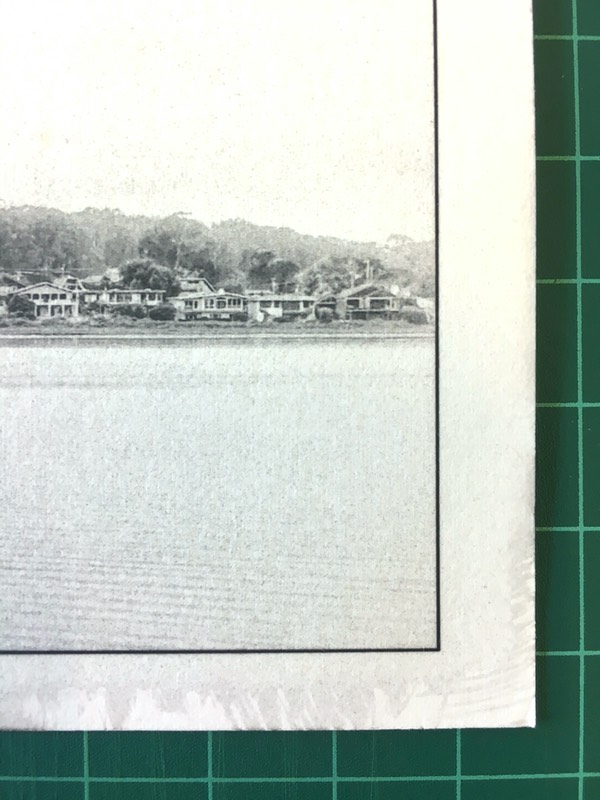Decomposing like all good organics, light sensitive Ferric Ammonium Citrate and Ferric Ammonium Oxalate iron compounds used for Siderotype printmaking processes will self-destruct. Sunlight, heat and time are all aggressors of a good iron based light sensitive emulsion. The results of this decay will be various forms of a fogged print - inability to clear to paper white, highlight staining, precipitation of precious metals before emulsion application. All bad for happy printmaking.
Bad Ferric Ammonium Citrate, Part A of Cyanotype, results in staining areas of no exposure and fogged highlights. Bad Ferric Ammonium Oxalate, Solution #1 of Ziatype, is similar to the Cyanotype failure mode of staining and fogging while including precipitation of the metals used in the process - palladium, gold, tungsten - resulting in metal particulates forming in the emulsion before even being applied to the paper substrate.
Corrective action for these two processes, Cyanotype & Ziatype, is the inexpensive replacement of their respective mix-in light sensitive ferric components. For Ziatype, there is no need to replace the expensive precious metals, and to be thrifty with Cyanotype the inexpensive potassium ferricyanide (Part B) is perfectly useable. Corrective action for Vandyke Brown, New Cyanotype, and Agryrotype is more complicated as the light sensitive ferric compounds are pre-mixed into their respective one-part emulsion solutions. When these chemistries fog, a full replacement of the chemistry is required. Cost-wise, not great for Vandyke Brown ($0.40 / 2ml) but spendy for New Cyanotype ($1.44 / 2ml emulsion) and Argyrotype ($2.40 / 2ml emulsion).
Ferric Ammonium Oxalate Gone Bad:
Bostick & Sullivan authored a concise note about its behaviors
https://www.bostick-sullivan.com/articles/ferriccoalate.html
The punch line (for all light sensitive iron salts):
Coat a small sheet, dry and develop without exposure. If a grey tint or stain remains after clearing, then the Ferric Ammonium Oxalate has gone bad. The color of fresh sensitizer is a vibrant yellow/green in color, but will not truly indicate its use-by date by color alone.
Cyanotype and mold growing in the Part A chemistry:
Mold (mould) and Ferric Ammonium Citrate: best solution is adding a few crystals of Thymol to the mix. The crystals will not dissolve and will make the sensitizer smell like mothballs. Good luck finding it however - there are a few odd sellers at eBay that sometimes carry it. Thymol is not something Bostick & Sullivan nor Photographers Formulary have tended to cary.
Good emulsion hygiene:
- When not in use, store all emulsion chemistry in a cold dark place. Not exactly the Traveling Wilburys song, but close.
- When in use, work under low light away from UV sources. No fluorescent bulbs. No bright incandescent. Just dim warm light, enough to work by. No need for red/amber safelights, a 15-25W yellow bug light would be perfect.
- Cyanotype Part A, Ferric Ammonium Citrate, will grow mold. It just will. No harm, no foul, it’s just a pain you don’t want mixed into your emulsion. Skim it out with a pick, filter it out with moistened cheesecloth (our favorite) or covfefe filter (meh), or prevent it all together by adding a fungicide to the storage bottle thus terminating it with extreme prejudice.
- Even with a fungicide, mold will grow in a dropper if stored with the Ferric Ammonium Citrate sensitizer. So, cap only on the storage bottle, no cheating by storing with a dropper.
- Silver based emulsion mixes must never be stored in plastic bottles or with plastic droppers. The silver will quickly plate out onto the plastic and render the emulsion impotent.
- Silver based emulsions should never be stored with glass dropper caps either. Silver will eventually plate onto the glass dropper, diminishing the effectiveness of the solution. Silver does not seem to plate onto the sides of glass amber bottles, so there is some oddity in behavior between the glass storage bottle and glass droppers. Store in amber bottle with cap only, no dropper.
- Ziatype chemistry seems compatible with both plastic and glass dropper caps for all chemistry solutions, stored in glass amber bottles. Ferric Ammonium Oxalate, Solution #1 of Ziatype, will go bad. We have not determined if storage with a dropper cap plays into this failure mode.
- Avoid returning extracted chemistry into its storage bottle. No need to risk inadvertent contamination. Always draw just what is needed, dispose the rest.
- Always rinse and clean extraction tools before drawing liquids. Make sure the dropper or pipette is clean before each use.
- Always clean the mixing bowl and mixing tool before mixing up the final solution for coating. No need to contaminate the few milliliters of liquid just before application.
- Always clean the application tool (brush, rod, etc.) before applying emulsion onto the intended substrate. Make sure all previous emulsion has been thoroughly washed off and out.

Ferric Ammonium Oxalate gone bad with this Ziatype (66%Pd, 17%Au, 17%W)
Failure Modes:
— Inability to clear
— Fogged highlights
— Precipitated metal particles visible in uncleared paper white

Fogged Ferric Ammonium Citrate, Part A of Cyanotype, with Arches Platine:
Failure Modes:
— Inability to clear
— Fogged highlights
Healthy Ferric Ammonium Citrate, Part A of Cyanotype, with Arches Platine:
Healthy Modes:
— Clears to paper white
— Highlights are correctly represented
